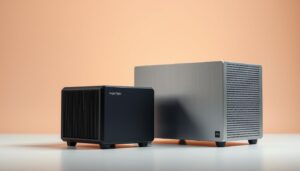
#image_title
Imagine a small Chinese AI company changing the whole AI world. DeepSeek R1, worth $5.5 million, has outperformed big tech with much less money. The U.S. AI market, worth about $500 billion, is facing big changes. Investors are worried, and Nvidia stock is falling. But is this really the AI revolution everyone’s talking about? Let’s dive into the details1.
DeepSeek R1 is way cheaper than OpenAI’s o1 model, costing $2.19 per 1 million output tokens compared to OpenAI’s $60.00. It uses about 50,000 NVIDIA H100s and matches OpenAI’s o1 for just 3% of the cost. DeepSeek trained on 2048 H800 GPUs and reached OpenAI’s o1 level in just one week1.
DeepSeek has quickly become popular at top universities like Stanford and MIT. Aabhas Sharma says DeepSeek is a strong rival to big models like ChatGPT and Gemini. The Chinese AI sector, including DeepSeek, is seen as innovative due to export controls and trade restrictions1.
Key Takeaways
- DeepSeek R1 is valued at $5.5 million, disrupting the $500 billion U.S. AI market.
- It costs 96.4% less than OpenAI’s o1 model, priced at $2.19 per 1 million output tokens.
- DeepSeek R1 matches OpenAI’s o1 capabilities for just 3% of the cost.
- The model gained rapid popularity among researchers at Stanford and MIT.
- Export controls and trade restrictions are driving innovation in China’s AI sector.
The Revolutionary Impact of DeepSeek R1
DeepSeek R1 has changed the AI world with its low cost and high performance. It costs just $5.5 million, much less than the billions spent by others. This AI is not just a tech wonder but also a big money saver.
Breaking Down the $5.5M Cost Structure
DeepSeek was made for about $6 million, much less than what big U.S. companies like OpenAI and Google will spend. It’s cheaper because of new ways to use resources and cut down on computer costs2. The model uses 1.5B to 70B parameters, making it powerful yet affordable3.
Comparison with Traditional AI Development Costs
Old AI models cost a lot, over $1 trillion in the next few years2. DeepSeek R1 makes advanced tools cheaper, helping education and science3. This change is changing how we see AI, showing open-source models can shake things up.
Initial Market Response to the Announcement
The news shook the stock market. Nvidia’s stock fell 17%, losing $600 billion in value2. This shows worries about China’s AI growth. Yet, DeepSeek R1 was a hit, topping Apple’s App Store2.
“DeepSeek R1’s cost-performance breakthrough is a testament to China’s strategic position in the global AI race.”
DeepSeek R1’s success makes us think about AI’s future and who can use it. It’s a big deal for making AI more accessible to everyone.
Understanding DeepSeek R1’s Technical Architecture
DeepSeek R1’s tech is a big deal in AI. It uses a new way to do deep learning. This lets AI models work well even with fewer GPUs. It shows how AI can change with better efficiency and scale.
The model is trained in a special way. It starts with supervised learning and then uses reinforcement learning. This makes it think like humans and learn values4. DeepSeek R1 did really well on a test, beating OpenAI’s model5. It can solve hard math problems fast, in just 35 seconds5.
- A parameter count of 671 billion, ensuring robust performance5.
- Distilled versions that can run on GPUs with as little as 6GB of VRAM, making it accessible for local deployment5.
- A multi-stage training process that integrates reasoning-specific rewards for tasks like math and coding4.
“DeepSeek R1’s architecture is a testament to how innovation can redefine the boundaries of AI development.”
This model is changing how we see AI. It’s accurate and affordable, costing just $0.14 per million tokens5. DeepSeek R1 is more than tech; it’s making AI available to everyone.
The Cost-Performance Breakthrough
DeepSeek R1 has changed the game in AI development, showing huge cost savings. It was made for just $5.5 million, proving that AI can be affordable without needing expensive GPUs6. This model performs as well as OpenAI’s GPT-4 but costs much less, making it a big deal in the field7.
Training Efficiency Metrics
DeepSeek R1’s training is super efficient. It uses H800 chips, which are less powerful than H100 chips, but still gets great results6. This shows that AI can be made without breaking the bank, setting a new cost-effective standard.
Resource Utilization Innovations
The model’s use of resources is truly innovative. DeepSeek R1’s biggest model costs 27 times less to run in the cloud than OpenAI’s GPT-47. This is thanks to smart chip use and training methods, showing that cost savings in AI are possible.
Performance Benchmarks Against Leading Models
In tests, DeepSeek R1 keeps up with GPT-4 on key tasks6. It shows that AI can be top-notch without needing pricey hardware. This makes DeepSeek R1 a strong contender in the debate against GPT-4.
Market Implications for US Tech Giants
The rise of DeepSeek R1 is changing the game in the us vs china ai race. It has big implications for US tech giants. DeepSeek’s AI model was made for just $5.5 million, which is a fraction of the $500 billion US AI market. This breakthrough is a game-changer in the ai revolution 2024, making companies like Nvidia rethink their plans8.

Nvidia, a major player in AI hardware, has already seen the effects. After DeepSeek’s success, Nvidia lost nearly $600 billion in market value. This shows the nvidia stock ai impact9. It also points to Jevons’ Paradox—making AI cheaper could lead to more demand, bringing both chances and challenges to the industry.
“DeepSeek’s entry into the market is a wake-up call for US tech giants. The cost-efficiency of their models could redefine the global AI landscape.”
Here’s how DeepSeek is shaking things up:
- DeepSeek’s R1 model uses just 2,000 chips, compared to 16,000 for competitors9.
- Its operational costs are 20-50 times lower than OpenAI’s offerings10.
- The app became the most downloaded free app in the US within a week of its launch9.
As the ai revolution 2024 moves forward, US tech giants must adjust. The us vs china ai race is getting fiercer, and the stakes are higher than ever.
China’s Strategic Position in the Global AI Race
China is making big moves in the AI race, becoming a strong competitor. The government is backing it up, focusing on innovation. This has helped China catch up with the U.S. fast.
The development of models like DeepSeek R1 shows China’s progress. It was built for under $6 million and beats models from big names like Google and Meta. This proves China is leading the AI race1112.
The Chinese government has been key to this success. By 2022, companies like High-Flyer bought 10,000 Nvidia A100 GPUs before U.S. rules blocked them. This ensured they had the needed hardware11.
This smart move, along with big investments, fits with the 2024 AI investment trends. China wants to be the global leader by 203011.
Government Support and Investment
China’s AI goals are driven by strong government support. Partnerships and funding help companies innovate at lower costs. For example, Kai-Fu Lee’s firm trained a model for just $3 million, showing China’s efficiency in AI development11.
Research and Development Infrastructure
China’s R&D setup is also crucial. DeepSeek used 2,000 Nvidia H800 chips, showing China’s ability to adapt and progress despite challenges12.
Talent Pool and Innovation Ecosystem
China has a huge talent pool and a strong innovation ecosystem. It focuses on education and teamwork, preparing the next AI experts. This is key for AI growth in the long run.
China’s smart investments, resourceful R&D, and talent development are changing the AI world. As 2024’s AI investment trends show, China is leading the AI race with each new innovation.
The Nvidia Factor: Stock Market Reactions and Future Prospects
The launch of DeepSeek R1 has caused big waves in the AI market. It has especially hit Nvidia’s stock price hard. After the news, Nvidia’s shares fell by almost 17% because of China’s growing AI skills13.
This drop shows the pressure from cheaper models like DeepSeek R1. It was made for just $5.5 million14.

DeepSeek R1’s success, trained on 2,000 Nvidia H800 GPUs, has made people wonder about AI hardware prices13. Experts think we will see more focus on smart algorithms, not just expensive computers15. This could make AI technology more accessible worldwide, leading to more success stories from startups.
“The emergence of cost-effective AI models like DeepSeek’s could transform the market, emphasizing efficiency over raw power.”15
Nvidia’s future is unclear. It has a wide Economic Moat Rating but a very high uncertainty rating14. The U.S. AI market, worth $500 billion, is set for big changes in the next decade. But for now, Nvidia is focused on dealing with this disruption13.
The AI race is getting fiercer, and the world politics will change too. China wants to be a leader in AI. This could change how countries work together in tech and change the game in the industry15.
Open Source vs. Proprietary AI Models
The debate between open-source AI models and proprietary solutions is changing the AI world. Models like DeepSeek R1 vs OpenAI focus on making AI more accessible and affordable. Open-source models are becoming popular because they make advanced technology available to more people. They don’t need expensive GPUs, making them easier for startups and researchers to use16.
Accessibility Benefits
Open-source AI models like DeepSeek R1 offer great accessibility. They let users change and adapt the technology to fit their needs. This is especially good for schools and small businesses that can’t afford expensive AI17. They also don’t need expensive hardware, making them cheaper18.
Community Development Potential
Open-source AI’s biggest strength is its community-driven development. Working together, like Meta’s open-source strategy, speeds up innovation16. This leads to faster progress and stronger solutions. But, it also brings up issues about who controls the project and how to keep quality high.
Security Considerations
Open-source AI models are transparent but also raise security concerns. Their openness can lead to misuse if not managed well. It’s important to create rules for using AI responsibly16. Finding a balance between openness and security is a big challenge, but it’s key for open-source AI’s success.
Jevons’ Paradox in AI Computing
The rapid growth in AI is striking, especially Jevons’ Paradox. It says that as AI gets cheaper and more efficient, people might use it even more. This paradox suggests that even with cost savings, we could end up using more resources.
For instance, DeepSeek’s AI model uses less powerful chips than OpenAI’s but is still getting a lot of attention19.
This paradox has big implications. Experts think that more efficient AI could mean more people using it, which could increase chip demand19. Companies like Meta and OpenAI are already planning to spend more on AI. Meta aims to spend $65 billion on AI by 202519. OpenAI’s $500 billion Stargate project shows the big investment in AI19.
“The narrative suggests that American tech companies may be overvalued, with costs related to training AI models being considered excessive and wasteful.”20
As AI becomes easier to use, it will be used in more areas. DeepSeek’s R1 model, made under U.S. rules, shows innovation can happen with less money20. This could make AI more available to everyone, but it also makes us wonder if we’ll use more resources. Only time will show.
Reshaping the Future of AI Development
The AI race just got a lot more exciting. DeepSeek R1 is not just another AI model; it’s a game-changer. It shows that innovation doesn’t have to be expensive, costing under $6 million and taking just two months to develop21. This is big because it challenges the idea that only expensive GPUs can lead to top performance.
For startups, this is a huge chance. DeepSeek R1’s affordability means even small companies can get advanced AI tech without spending a lot on GPUs22. This makes the playing field more even, letting startups compete with big tech companies. Here’s how DeepSeek R1 is making a splash:
- Lower costs mean faster innovation cycles.
- Less need for expensive hardware makes AI more accessible.
- An open-source framework encourages worldwide collaboration and improvement22.
DeepSeek R1’s impact goes beyond saving money. It’s changing how we think about AI development. It shows that AI models that don’t need expensive GPUs can still do great21. As the global AI market keeps growing, DeepSeek’s way could change the industry’s future. It could make advanced AI available to everyone.
The Hidden Challenges Behind DeepSeek R1’s Success
The deepseek r1 is seen as a big win for Chinese AI. But, its success comes with big challenges. One major worry is hidden biases in its algorithms. These biases could limit its use in important areas like healthcare and education23.
Another challenge is its need for lots of resources. Deepseek r1 uses special training to save memory, but it still needs thousands of GPUs for training24. This makes it hard for smaller groups to use.
“The transparency in reasoning chains provided by DeepSeek R1 allows for easier error identification, but this doesn’t eliminate the risk of systemic flaws.”24
Here are some key challenges to consider:
- Bias Detection: Making sure it’s fair across different data sets is tough23.
- Scalability: It’s cheap but still needs a lot of computing power24.
- Performance Gaps: It’s good on some tests but not others, like ZebraLogic25.
The impact of deepseek r1 on AI is clear. But, solving these challenges is key for its lasting success. As AI keeps changing, being open and flexible will show if this model is a real game-changer or has limits in real use.
Conclusion: A New Chapter in the Global AI Race
DeepSeek R1 has changed the game in the AI race between the US and China. It shows that you don’t need to spend billions to innovate. With a cost of just $5.6 million, it challenges the big players like OpenAI and Google, who spend billions every year26.
This breakthrough is a big deal for startups and smaller companies. They can now compete in the 2024 AI revolution27.
DeepSeek R1 stands out because of its lightweight design. It works faster and costs less than Western rivals like ChatGPT28. It also understands many languages and is sensitive to different cultures, giving it an edge in various markets28.
Early tests show it can match or even beat GPT-4 in some areas. This is a big change in the AI world26.
The market is feeling the impact. Big names like Nvidia, Google, and Microsoft have seen their stocks swing after DeepSeek’s launch26. This shows how affordable AI can change the game, making it fairer for everyone27.
As the AI race gets fiercer, DeepSeek R1 shows China’s growing role. With government backing, a skilled workforce, and new ideas, China is becoming a major player in AI28. The future of AI is no longer just about the West, and DeepSeek R1 is leading the way.
In this 2024 AI revolution, DeepSeek R1 vs OpenAI is more than a competition. It shows the power of creativity and efficiency. As AI keeps changing, one thing is clear: the race is far from over, and the stakes are higher than ever.
FAQ
What is DeepSeek R1 and how is it disrupting the AI market?
How much does it cost to train DeepSeek R1 compared to traditional AI models?
What are the technical innovations behind DeepSeek R1’s efficiency?
How is DeepSeek R1 impacting the US tech giants and the broader AI market?
What is China’s strategic position in the global AI race, and how does it compare to the US?
What are the benefits and drawbacks of open-source vs. proprietary AI models like DeepSeek R1?
How does Jevons’ Paradox apply to the AI computing revolution, and what are the implications?
What are the potential implications of DeepSeek R1 for the future of AI development and startups?
Source Links
- Industry insiders say DeepSeek’s focus on research makes it a dangerous competitor as it’s willing to share breakthroughs rather than protect them for profits
- What is DeepSeek, and why is it causing Nvidia and other stocks to slump?
- DeepSeek-R1: What to Expect from This Revolutionary AI Tool
- DeepSeek R1: It’s All About Architecture and Training Approach
- A Simple Guide to DeepSeek R1: Architecture, Training, Local Deployment, and Hardware Requirements
- What DeepSeek’s breakthrough says (and doesn’t say) about the ‘AI race’ with China
- What DeepSeek r1 Means—and What It Doesn’t
- What Does DeepSeek Mean For Industrial Enterprises?
- DeepSeek: Trump warns of ‘wake-up call’ for US tech firms
- Explained: Why China’s DeepSeek triggered a slide in global AI stocks
- China heralds DeepSeek as a symbol of AI advancements amid U.S. restrictions
- What’s DeepSeek, China’s AI startup sending shockwaves through global tech?
- DeepSeek Hype Vs. Nvidia And Apple: Will Calmer Minds Prevail?
- Nvidia: Maintaining Fair Value Estimate Despite AI Model Efficiencies Deployed by DeepSeek
- Nvidia Shares Tumble as Chinese AI Startup DeepSeek Sparks Market Shakeup
- Open Source Chinese DeepSeek AI Surpasses Proprietary Models
- DeepSeek Disrupts the AI Game with Open Source R1 Model
- DeepSeek Open-Source Model Could Shake Up Enterprise AI | PYMNTS.com
- DeepSeek sparked a market panic — but some think the sell-off is overblown
- 7 Ways to Think About the DeepSeek AI Freak-out
- DeepSeek: The Chinese AI Startup Reshaping The U.S. Tech Industry
- DeepSeek’s R1 Model Sparks Debate on the Future of AI Development – FinTech Weekly
- What DeepSeek-R1’s Rise Means for Meta (And Why They’re Playing Catch-Up)
- DeepSeek-R1’s bold bet on reinforcement learning: How it outpaced OpenAI at 3% of the cost
- SmythOS – DeepSeek R1: Reshaping AI Reasoning Models
- The DeepSeek Revolution: How Innovation Born from Constraint is Redefining the Future of Global AI
- DeepSeek R1 Outshines ChatGPT, Spurring AI Race: OpenAI’s Sam Altman Responds!
- DeepSeek Mayhem: How Chinese AI Startup Compares with ChatGPT, Others







